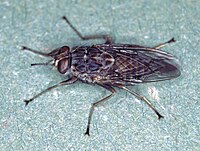
Photo from wikipedia
Simple Summary Tsetse flies transmit Trypanosoma parasites, which cause severe diseases in humans and animals. To reduce the number of tsetse flies, male flies are sterilized through irradiation and released… Click to show full abstract
Simple Summary Tsetse flies transmit Trypanosoma parasites, which cause severe diseases in humans and animals. To reduce the number of tsetse flies, male flies are sterilized through irradiation and released into the field to compete with wild male flies for mating with wild females. Recently, two insect-specific viruses were discovered in mass-reared Glossina morsitans morsitans tsetse flies. The aim of this study was to evaluate whether these viruses are affected by the irradiation treatment. The results showed that irradiation did not change the number of viral genome copies in the flies. Abstract Tsetse flies are cyclic vectors of Trypanosoma parasites, which cause debilitating diseases in humans and animals. To decrease the disease burden, the number of flies is reduced using the sterile insect technique (SIT), where male flies are sterilized through irradiation and released into the field. This procedure requires the mass rearing of high-quality male flies able to compete with wild male flies for mating with wild females. Recently, two RNA viruses, an iflavirus and a negevirus, were discovered in mass-reared Glossina morsitans morsitans and named GmmIV and GmmNegeV, respectively. The aim of this study was to evaluate whether the densities of these viruses in tsetse flies are affected by the irradiation treatment. Therefore, we exposed tsetse pupae to various doses (0–150 Gy) of ionizing radiation, either in air (normoxia) or without air (hypoxia), for which oxygen was displaced by nitrogen. Pupae and/or emerging flies were collected immediately afterwards, and at three days post irradiation, virus densities were quantified through RT-qPCR. Generally, the results show that irradiation exposure had no significant impact on the densities of GmmIV and GmmNegeV, suggesting that the viruses are relatively radiation-resistant, even at higher doses. However, sampling over a longer period after irradiation would be needed to verify that densities of these insect viruses are not changed by the sterilisation treatment.
Journal Title: Insects
Year Published: 2023
Link to full text (if available)
Share on Social Media: Sign Up to like & get
recommendations!